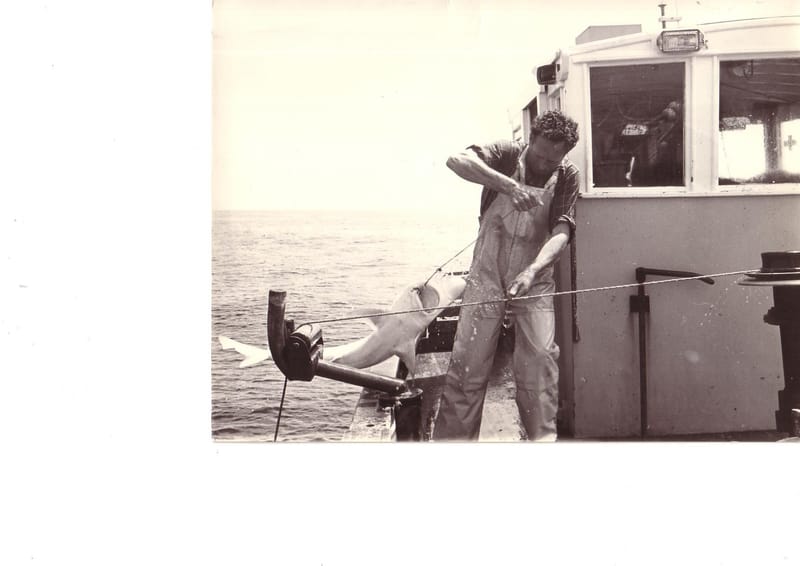San Remo's Fishing Heritage
San Remo’s Fishing Heritage Hastings was the main fishing port in Western Port in the 19th and early 20th century. With the introduction of the first permanent ferry service in 1876 the few fishermen at Griffiths Point could send their fish by the...
San Remo’s Fishing Heritage
Hastings was the main fishing port in Western Port in the 19th and early 20th century.
With the introduction of the first permanent ferry service in 1876 the few fishermen at Griffiths Point could send their fish by the ferry to Hastings, and then by horse drawn coach overnight to Melbourne.
When the rail was put through to Stony Point in 1889 fish was taken from Hastings direct to Melbourne by train .
Prior to the construction of the railway, horse drawn trams had brought coal to San Remo for transportation by boat to Melbourne.
The Wonthaggi coalfields were opened in 1909 and the railway was built from Nyora to Wonthaggi in 1910. This enabled the fast transport of fish to the Melbourne Fish Market via the Anderson railway station.
Doug Carmichael and Charlie Blackney each had a truck they used to cart fish from San Remo to Anderson Station from c1930.
An early fishing pioneer of San Remo was Vivian Leslie Heazlewood , who was drowned with Cecil Andrews in 1936, off Cape Woolamai when hit by a heavy storm.
He was the son of William Leslie Heazlewood who came to San Remo c1911.
According to the voters list William was at Portland in 1903, Welshpool in 1909 and San Remo in 1912.
His grandfather Robert Heazlewood had come from Tasmania to Portland , with the colonial squatting family the Henty’s, who employed him as a blacksmith.
Vivian fished for a short period in Cowes, before moving to San Remo to be near the rail line, as it enabled him to send fish more easily to the Melbourne market.
Vivian, his brother Louis and father William were all fishermen.
Sadly he was fishing off Cape Woolamai in 1936, when his boat was hit by a heavy squall.
The boat and the two fishermen on board disappeared without trace.
The Churchill and Dickie names are also synonymous with the early San Remo fishing industry.
In the early days of the industry, which centred around the San Remo wharf, the pier was a small T shaped construction, with just a small shed to serve as a base.
It was also used by the ferries and mailboats which operated around the bay.
As time passed there was not enough space for the many boats in the industry to tie up there, so they were moored on swing lines off the wharf.
In the 1930s, a circular shaped breakwater was constructed to give better mooring for the boats.
But it was found to silt up the harbour too much, so the shape was changed to a straighter breakwater.
By the late 1940s, about 70 couta boats were basing from San Remo, and at their peak 800 to 1,000 boxes of fish were sent off to market by road train each day.
As the fishing business increased, the pier was extended.
A new side leg was added forming an F shape in the 1940s and a lower section, which created an E shape, was built in the 1960s.
Boats
The wooden couta boats were only about 20 to 30 feet long.
In the 1940s it became popular to fish for flathead on long lines.
At that time the fish were prolific in the spring, before the start of the barracouta season, and two men using long lines could catch up to 15 boxes a day.
With each containing 35 to 40 kilos of fish, it was a lucrative sideline.
The period from Show Day in September to Cup Day was always regarded as flathead time.
And November was couta month.
Couta were caught by towing several lines behind the boat with a hook on the end baited with a piece of cow hide.
But long line fishing was very labor intensive, with hundreds of baits having to be attached individually.
When the Danish Seine trawlers started to sweep the area from Eden to Cape Otway in the 1950s, the number of flathead caught reduced.
Fishermen also reported that couta numbers had dropped, and few were caught from then on along the Victorian coastline.
The same applied to blue fin tuna, once relatively plentiful in the area.
Freezer
Block ice was supplied by Jack French, of Cowes, or brought from Dandenong, for the preservation of the catch, but it became obvious that there was a need for a large freezer.
The Fisherman’s Co-Operative building, which became operational in 1952, was one of five similar facilities built along Victoria’s south coast.
The objective of these was to assist in the further development of a state wide fishing industry.
They were based at Apollo Bay, Lorne, Barwon Heads, Queenscliff and Newhaven,
Local fisherman Jock Dickie took eight years off the boats, to work as a bricklayer on their construction.
Freezer rooms were installed primarily to even out the seasonal glut of fish and to stabilise the price.
But they were never quite large enough to contain the catch, and a more effective distribution system was necessary.
The main part of the funding for the building was supplied through government grants, with the expectation that the original members of the co-operatives would repay the government through levies on the boxes of fish they caught.
But eventually the repayment was waived.
The small shop attached to the co-op building was replaced with a larger one in 1978. Its upper story became an office.
Bill Hopkins, of Cowes, was the long term accountant of the fisherman’s co-operative.
Crayfishing reached a peak in the 1970s, and the Co-op freezer was used to store both fresh and cooked cray.
Gradually, the small boats were replaced with larger ones.
Gill netting for shark was introduced, and modern fishing boats became larger and expensively equipped, with electronic and mechanical navigational aids and echo sounders to locate fish.
About 26 local boats operated in the local area at the start of the 199os, with most tying up at San Remo but a few at Newhaven.
Flaked ice (a flaked iceworks was added at the Co-op in 1986) was used to preserve the fish in the boats, and transportation of the catch improved dramatically, with refrigerated vehicles ensuring freshness.
Fishermen were always versatile, changing methods to catch whatever was available at that time.
The fishing industry had long been the backbone of San Remo’s economy and most permanent residents pre 2000 had some connection to it during their lifetime.
Tourism
Tourism also come into its own, at the turn of the new century.
Its breadth of appeal and attractive setting had long made San Remo a popular getaway.
And with more than a touch of the old lifestyle still lingering, San Remo offered a haven for those seeking a different lifestyle.
San Remo today is a thriving and active fishing village, offering experiences such as fishing trips, ferry excursions and the fascination of a working pier to its thousands of visitors annually.
The introduction of Pelican Feeding outside the Co-op as an attraction proved to be highly successful, and sees many thousands of visitors stop over to enjoy this spectacle.
Access from the highway is easy, and San Remo’s fishing theme continues to offer an enticing invitation to travellers to stop and enjoy the atmosphere, activity and services on its bustling foreshore.




